Literally cooked in hot water—what happened in the latest mass coral bleaching on the Great Barrier Reef
By Janice Lough | June 29, 2020
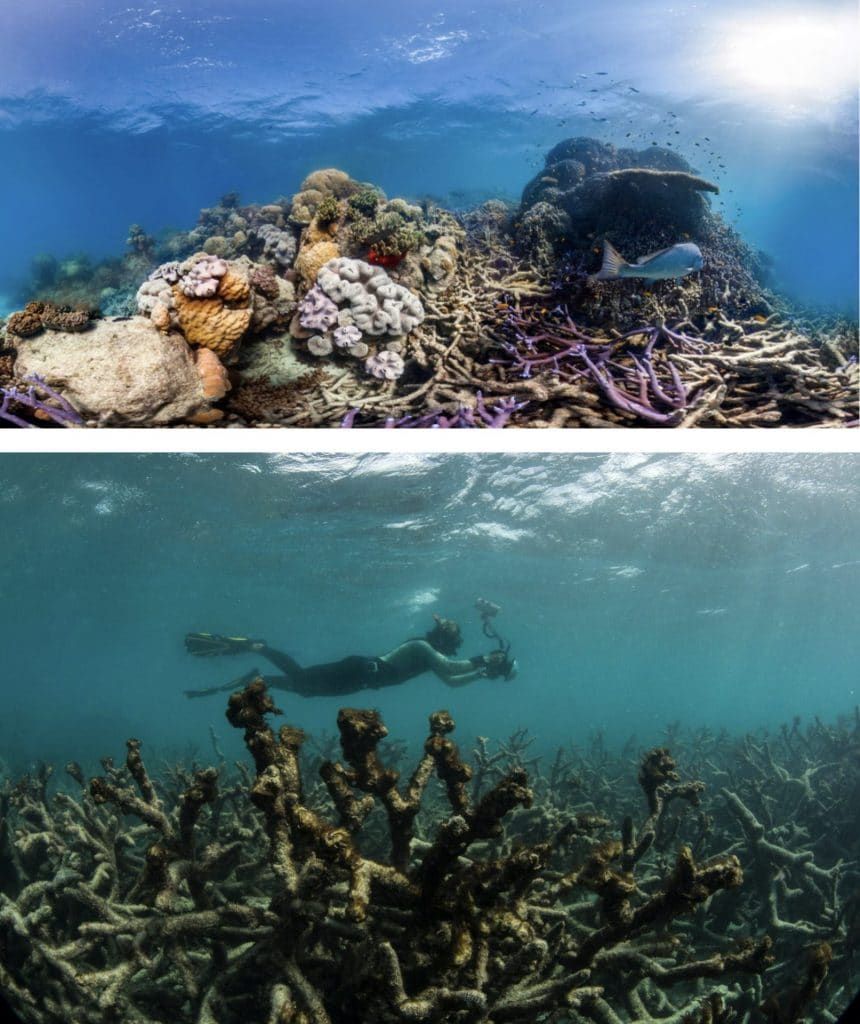 Before the 2016 bleaching event on the Great Barrier Reef in Australia (top), and after (bottom). Image courtesy XL Catlin Seaview Survey.
Before the 2016 bleaching event on the Great Barrier Reef in Australia (top), and after (bottom). Image courtesy XL Catlin Seaview Survey.
In February 1929—the height of summer in Australia—a team from the Great Barrier Reef Expedition reported a curious sight. At a section of reef known as Low Isles, 65 kilometers (a little over 40 miles) north of Cairns, the shallow waters of the reef’s pools were “literally hot to the touch” and contained “great numbers of whitened skeletons of corals.”
They laid the phenomenon to the coincidence of low spring tides and dead calm weather at the hottest time of the year.
It was the first recorded scientific observation of coral bleaching on the Great Barrier Reef.
Back then, this was a relatively rare, small-scale event, that only occurred when all the various conditions happened to be in perfect sync.
That is no longer the case. Coral bleaching is no longer rare, and no longer confined to a few tidal pools.
Instead, mass coral bleaching, in which many reefs are affected, has now occurred on the Great Barrier five times in the last 23 years. Three of these events were within the past five years, most recently in the summer of 2020. Bleaching is happening much more frequently, and much more intensively. My colleagues at the Australian Institute of Marine Science, James Cook University, and I—along with many others—have been studying these coral bleaching events in an effort to find out more about what factors are driving corals to bleach, whether the Reef can overcome them by itself—and what humankind can hope to do to help the corals. The findings, so far, are bleak—even more so than when I first wrote about coral bleaching for the Bulletin of the Atomic Scientists in 2016. Nevertheless, there are things we can do to change the situation, and some promising new possibilities have come up.
But first, some background.

Size and scale. The first thing that outsiders have to realize is that the Great Barrier Reef is BIG. It extends for over 2,300 kilometers (1,429 miles) along the north Queensland coast, containing an area of 344,400 square kilometers (132,974 square miles)—making it bigger than New Mexico and only slightly smaller than Germany. It is so large that it can be seen from space.
The second thing is that the name “Great Barrier Reef” is a bit of misnomer. Rather than one large contiguous unit as the name implies, it is actually more of a loose conglomeration of more than 2,900 individual reefs and 900 islands—some of them widely scattered.
Taken together, these factors mean that in order to conduct their research, scientists have to take to the air, flying about 450 feet above the ocean’s surface to survey the spatial extent and intensity of bleaching. (And the sheer size and scale mean that it can take time to follow up real-time satellite observations of sea surface temperatures from preliminary analyses made half a world away.) In early 1998, the US National Oceanic and Atmospheric Administration forwarded satellite reports of waters that were much warmer than normal; to determine if there was any subsequent coral bleaching and its extent, researchers aboard low-flying planes divided reefs into 5 categories, according to the proportion of coral cover that appeared white from above. These categories ranged from zero (no bleaching) to four (indicating more than 60 percent of a reef was bleached). Of the 654 reefs surveyed, 45 percent escaped bleaching, 42 percent were bleached to some extent, and 18 percent were severely bleached. Bleaching was mainly on nearshore reefs, and most severe in the central and southern parts of the Reef.
Four years later, in 2002, warm summer conditions led scientists to return to the skies above the Great Barrier Reef. Surveying 651 reefs they found similar figures, but this time the bleaching affected more offshore reefs.
But to put coral bleaching into perspective, one has to understand what a coral is, what bleaching is, and what is coral death.
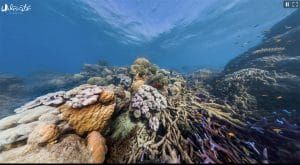
Defining terms. Corals are marine animals without backbones—invertebrates—which form colonies of many individual organisms, known as polyps. They extract calcium and carbonate from seawater to construct hard skeletons for their support and protection. This process of calcification produces the diverse and complex reefscapes that support many hundreds of thousands of animals and plants, making tropical coral reefs one of the most biodiverse ecosystems on Earth. The challenge for corals is to keep building their skeletons to withstand the natural forces of physical and biological erosion—and this requires energy, and lots of it.
This extra energy comes from a special, mutually beneficial relationship, or symbiosis, between the corals and single-celled plants such as photosynthetic algae, known as zooxanthellae. These algae live protected in the coral tissue and gain essential nutrients from their coral host. In return, the coral feeds on the by-products of photosynthesis conducted by the algae, which can provide up to 90 percent of the corals’ nutritional needs. Pigments in the algae also give corals their color.
But like any relationship under stress, it can break down. When conditions become severe enough, the coral expels the algae, the tissue becomes translucent, and we see the white calcium carbonate skeleton underneath—hence the term “bleaching.”
And conditions have to be just right for this relationship to flourish; consequently, corals cannot thrive everywhere in the tropical oceans. Their distribution is constrained within a narrow range of environmental conditions relating to water temperature, salinity, light, water clarity, acidity, and chemistry. Consequently, several different sources of stress can cause corals to move outside their comfort zone and become bleached. Waters can, for example, be too hot, too cold, too salty, too fresh, too acidic, too full of sediment—like Goldilocks, corals want it “just right.” These causes of stress and bleaching are usually very localized—except for unusually warm temperatures, which we are seeing more of because of climate change.
Corals are most at risk of such thermal stress in high summer, when water temperatures are at their local seasonal maximum. They live only 1-to-2 degrees Celsius (about 1.8-to-3.6 degrees Fahrenheit) below their threshold for heat tolerance, so unusually warm waters over a matter of even just a few weeks is sufficient to cause them to bleach.
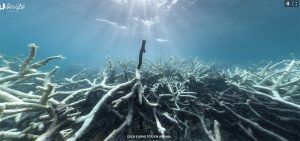
Anatomy of a bleaching event. After two widespread and unprecedented bleaching events in 1998 and 2002, the next 13 years were very quiet for thermal stress and bleaching—but six Severe Tropical Cyclones (similar to the hurricanes off the United States) travelled through the Great Barrier Reef between 2005 and 2011, including the first Category 5 Cyclone to cross Australia’s east coast since 1918.
Tropical cyclones cause much physical damage to reefs, turning them into what looks like a pile of rubble and even upending centuries-old massive coral colonies that are several meters high. The cyclones also brought freshwater floods from adjacent rivers, making low salinity and sediment-laden waters come to the reef. Corals do not like these extreme conditions, and it takes decades for the Great Barrier Reef to recover from such events. Meanwhile, the time between these extreme weather events is getting shorter as the global climate system continues changing. (A warmer atmosphere, for example, can hold more moisture—so more rain now falls during extreme weather events than happened in the past).
The summer of 2016 was another overly warm one, and scientists had to take to the air again to assess the damage. Surveying 1,156 reefs, they found only 9 percent had escaped bleaching and 48 percent had severe bleaching, four times the levels recorded in 1998 and 2002. This time, bleaching was most severe in the most pristine northern sector, least affected by human activities.
To make matters worse, warm waters returned the next year. Combined, the back-to-back bleaching years of 2016 and 2017 resulted in severe bleaching across 35 percent of the Reef area, compared to 2 percent in 1998, and 6 percent in 2002. Then, unthinkably, bleaching occurred again in 2020—for the third time in five years. The results in 2020 were not quite as bad as 2016, but a worse outcome than in 2017, 2002, or 1998. Tellingly, the title of an article by Great Barrier Reef researchers in The Conversation used the terms “utter tragedy” to describe the situation.
Climate and weather as drivers of bleaching. The global climate system is rapidly warming as more and more greenhouse gases, principally carbon dioxide, are pumped into the atmosphere. Since the Great Barrier Reef Expedition landed on Low Isles in 1928, global land and sea temperatures have warmed by 0.8 degrees Celsius (1.4 degrees Fahrenheit), waters of the Great Barrier Reef by 0.7 degrees Celsius (1.3 degrees Fahrenheit), and we have added an extra 105 parts per million of carbon dioxide to the atmosphere. And there are also now nearly four times as many people on the planet.
A changing climate is unequivocally driving the increased frequency, extent, and intensity of mass coral bleaching events on the Great Barrier Reef and tropical coral reefs worldwide. The patterns we are observing by plane of bleaching occurrence and intensity closely match the levels of thermal stress derived from satellites.
Natural sources of climate variability are still occurring but against a backdrop of warmer water temperatures. The major cause of inter-annual climate variability throughout most of the tropics and extending to higher latitudes are El Niño-Southern Oscillation events. The two extremes, El Niño and La Niña, cause a range of climate anomalies, including droughts, floods, and changed locations of tropical cyclone activity. Large parts of the tropical oceans, including the Great Barrier Reef, are typically warmer than average during an El Niño event. Bleaching on the Reef in 1998 and 2016 was linked to the very strong El Niño events of 1997-1998 and 2015-2016. This boost of natural climate variability on top of global warming caused 1998 to be the then warmest year on record—and 2016 is now the warmest year on record, throughout the globe.
Worryingly, bleaching events are now occurring on the Great Barrier Reef without being driven by El Niño events, as happened in 2017 and 2020.
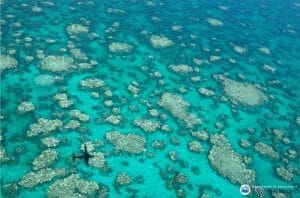
A reef after bleaching. So what do all these facts and figures mean for the Great Barrier Reef?
Some corals die immediately, literally cooked in the hot water. Some corals starve to death more slowly after their source of cheap food (the algae) has been lost. Dead corals are overgrown by seaweeds. The extent of mortality is directly related to the intensity of heat stress—in the most severe event of 2016, an estimated 29 percent of shallow-water coral cover was lost from the Great Barrier Reef, 75 percent of which was in the formerly pristine far north.
But not all corals die. Some recover their algal symbionts from the seawater, though in their weakened state they may be more susceptible to disease, grow more slowly and reproduce less. Some may not bleach at all, or even recover fully in a matter of weeks; the key to these survivors seems to lie with the particular type of algal symbionts they harbor—some types allow their coral host to withstand higher temperatures.
Different coral species respond to thermal stress differently, with the fast-growing branching corals more susceptible, and slower-growing massive corals more tolerant. The appearance and makeup of coral communities after severe bleaching becomes flatter and less diverse as the corals responsible for the complex three-dimensional structures succumb more readily to heat stress.
There are obvious follow-on effects to the reef-associated organisms which rely on live, healthy corals for their survival. Restoring a reef to its healthy pre-bleaching state is possible but it takes time: time for surviving corals to regain their algal partners and continue to grow; time for coral larvae to be produced on the reef or be imported from nearby unaffected reefs. About 10 years without disturbance is required for such recovery and this is just not happening on the Great Barrier Reef. Since 1985, a unique long-term monitoring program has regularly assessed the condition of a subset of reefs. Measurements of the amount of hard coral cover show that the Great Barrier Reef can recover from disturbances such as bleaching, tropical cyclones, Crown-of-Thorns Starfish outbreaks and diseases but that there are limits to their ability to bounce back; overall, there has been a widespread ratcheting down of coral cover. Almost every part of the Great Barrier Reef has suffered some major environmental disturbance in recent times.
And there is nowhere for the corals to hide.
The future Great Barrier Reef. The Paris 2015 goals of limiting global warming to 1.5-to-2 degrees Celsius (2.7-to-3.6 degrees Fahrenheit) will not prevent widespread changes to the Great Barrier Reef or other tropical coral reefs.
These reefs have already shown their extreme vulnerability to the 1 degree Celsius (1.8 degrees Fahrenheit) of warming that has already occurred since the late 19th century. Even if the Paris targets are rapidly met, reefs will have to contend with the consequences of the additional warming of the global climate system that are locked in by the Paris Agreement.
As the seas warm further, there will be more frequent, more intense, and more widespread bleaching events—as well as more extreme weather events such as destructive tropical cyclones and the surges of freshwater river floodwaters that they bring.
This downward trajectory will continue until the global climate is stabilized. The Great Barrier Reef will become simpler and less diverse, with new assemblages of only the most heat-tolerant of coral species; it will not be able to support the incredible diversity of other reef life that the Great Barrier Reef Expedition catalogued in the 1920s. Climate change is not a future event for the Great Barrier Reef; it is already happening, and already compromising this World Heritage Site.
If we continue on the path we have been taking, then more extreme levels of global warming will leave this international icon decimated and unrecognizable.
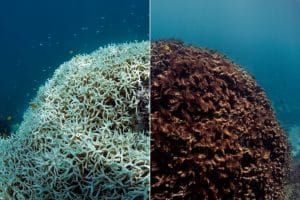
Human intervention. Human ingenuity got us into the current climate predicament for the world and the Great Barrier Reef. Can human ingenuity get us out of this mess?
Halting further global warming is the absolute key. Actions to achieve this are clear and doable but we still lack effective global commitment and leadership.
Fortunately, the world may already be changing its relationship with energy generation. For example, in the Australian state of Queensland—immediately adjacent to the Great Barrier Reef—renewable energy now accounts for 22 percent of total energy generation, with the Queensland state government committed to 50 percent renewables within 10 years. More than a third of the region’s households now have rooftop solar panels, compared to less than 5 percent only ten years ago, causing Queensland to live up to its nickname: “Sunshine State.”
But are there other interventions we can implement to help the Great Barrier Reef through this difficult time before, hopefully, we stabilize the climate system?
An ambitious, multi-institutional, Reef Restoration and Adaptation Program recently whittled down 160 ideas to about 40 potentially feasible interventions with some probability of success, that could be scaled up and assist the reef to adapt and recover from the effects of a changing climate.
These efforts include the selective breeding and planting of more heat-tolerant corals—in particular manipulating that special coral/algae symbiosis at the heart of healthy reefs. They also include stabilizing reef rubble on damaged reefs to encourage recruitment of coral larvae, and shading reefs by brightening clouds with salt crystals.
There is much work to be done and some of the ideas may seem far-fetched. But we have nothing to lose and everything to gain by helping this unique ecosystem survive into the future.
There is no time left to lose.
Together, we make the world safer.
The Bulletin elevates expert voices above the noise. But as an independent nonprofit organization, our operations depend on the support of readers like you. Help us continue to deliver quality journalism that holds leaders accountable. Your support of our work at any level is important. In return, we promise our coverage will be understandable, influential, vigilant, solution-oriented, and fair-minded. Together we can make a difference.
Keywords: El Nino, Great Barrier Reef, bleaching, climate change, climate crisis, coral bleaching, cyclones, global warming, ocean acidification
Topics: Climate Change















Where can one find the data on the elevated sea surface temperatures that caused the bleaching on the GBR?